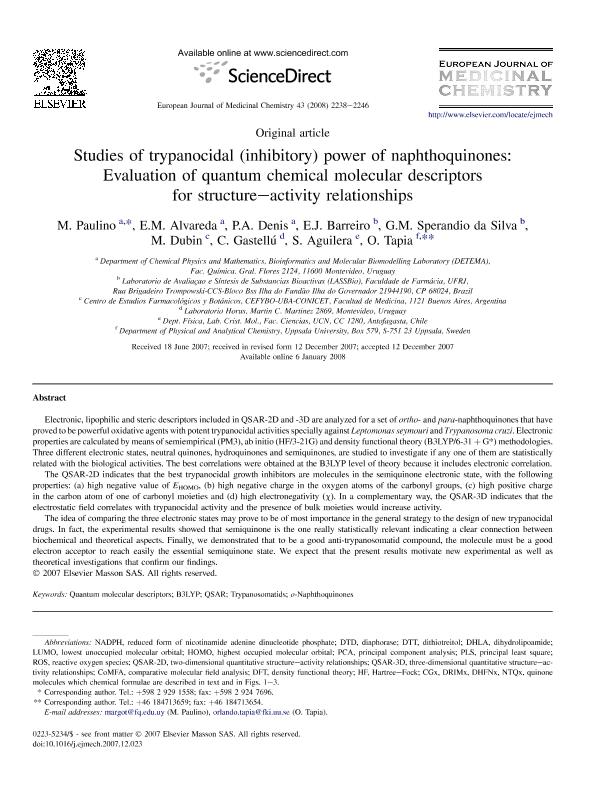Artículo
Studies of trypanocidal (inhibitory) power of naphthoquinones: evaluation of quantum chemical molecular descriptors for structure–activity relationships
Paulino, M.; Alvareda, E. M.; Denis, P. A.; Barreiro, E. J.; Sperandio da Silva, G. M.; Dubin, Marta ; Castellú, C.; Aguilera, S.; Tapia, O.
; Castellú, C.; Aguilera, S.; Tapia, O.
 ; Castellú, C.; Aguilera, S.; Tapia, O.
; Castellú, C.; Aguilera, S.; Tapia, O.
Fecha de publicación:
10/2008
Editorial:
Elsevier Masson
Revista:
European Journal of Medical Chemistry
ISSN:
0223-5234
Idioma:
Inglés
Tipo de recurso:
Artículo publicado
Clasificación temática:
Resumen
Electronic, lipophilic and steric descriptors included in QSAR-2D and -3D are analyzed for a set of ortho- and para-naphthoquinones that have proved to be powerful oxidative agents with potent trypanocidal activities specially against Leptomonas seymouri and Trypanosoma cruzi. Electronic properties are calculated by means of semiempirical (PM3), ab initio (HF/3-21G) and density functional theory (B3LYP/6-31 + G∗) methodologies. Three different electronic states, neutral quinones, hydroquinones and semiquinones, are studied to investigate if any one of them are statistically related with the biological activities. The best correlations were obtained at the B3LYP level of theory because it includes electronic correlation. The QSAR-2D indicates that the best trypanocidal growth inhibitors are molecules in the semiquinone electronic state, with the following properties: (a) high negative value of EHOMO, (b) high negative charge in the oxygen atoms of the carbonyl groups, (c) high positive charge in the carbon atom of one of carbonyl moieties and (d) high electronegativity (χ). In a complementary way, the QSAR-3D indicates that the electrostatic field correlates with trypanocidal activity and the presence of bulk moieties would increase activity. The idea of comparing the three electronic states may prove to be of most importance in the general strategy to the design of new trypanocidal drugs. In fact, the experimental results showed that semiquinone is the one really statistically relevant indicating a clear connection between biochemical and theoretical aspects. Finally, we demonstrated that to be a good anti-trypanosomatid compound, the molecule must be a good electron acceptor to reach easily the essential semiquinone state. We expect that the present results motivate new experimental as well as theoretical investigations that confirm our findings.
Palabras clave:
Quantum Molecular Descriptors
,
B3lyp
,
Qsar
,
Trypanosomatids
,
O-Naphthoquinones
Archivos asociados
Licencia
Identificadores
Colecciones
Articulos(CEFYBO)
Articulos de CENTRO DE ESTUDIOS FARMACOLOGICOS Y BOTANICOS
Articulos de CENTRO DE ESTUDIOS FARMACOLOGICOS Y BOTANICOS
Citación
Paulino, M.; Alvareda, E. M.; Denis, P. A.; Barreiro, E. J.; Sperandio da Silva, G. M.; et al.; Studies of trypanocidal (inhibitory) power of naphthoquinones: evaluation of quantum chemical molecular descriptors for structure–activity relationships; Elsevier Masson; European Journal of Medical Chemistry; 43; 10; 10-2008; 2238-2246
Compartir
Altmétricas



